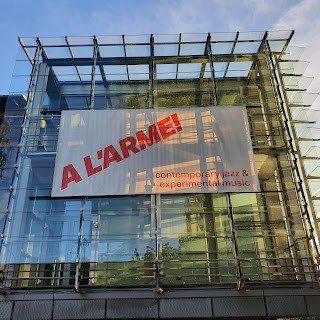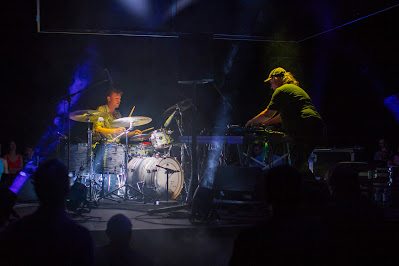
By Paul Acquaro
Since its inception in 2012, Berlin based organizers Louis Rastig and Karina Mertin’s A L’ARME festival has carefully avoided being defined as only a free-jazz festival. Sure, through the years free jazz icons such as Peter Brötzmann, Sven-Åke Johansson, Irène Schweizer, Han Bennink, John Butcher, Ken Vandermark, Lotte Anker, Ikue Mori, William Parker, Hamid Drake and Connie Bauer (among others, see our
coverage over the years) have played the festival; however this is just one side of what they want to present. Heavy rock and progressive metal acts such as Steamboat Switzerland, Bill Laswell’s Method of Defiance, Mohammad, and this year Shining, have played a major part in the programming, as have electronics. In fact 2018’s festival paid homage to Polish/Swedish electroacoustic composer Zbigniew
Karkowski and featured several electronics based acts.
This year, for the 10th anniversary of the festival, the programming was just as diverse, taking a wide view of experimental music in Berlin and beyond. The free jazz aspect was primarily represented on the third
night of the festival with sets by the Norwegian group Nakama and a trio featuring Ken Vandermark, Macie Stewart, and Ludwig Wandinger. Other nights of the festival featured metal, drum and bass, indie rock, poet Moor Mother who debuted a new project, “Jazz Codes,” experimental vocalist Maja S.K. Ratkje, and many more (check out the full program here). The first night of the festival, Wednesday the 10th, was held at the crematorium turned performance space Silent Green, however, we pick up here on
day two at the ‘traditional home’ of the festival, the Radialsystem.
Thursday, August 11th, Radialsystem
Upon entering the river side performance space Radialsystem, I missed the bowls of earplugs located near the entrance to the two halls, perhaps mistaking them for candy. What a mistake it was, the first group of the night, Berlin’s ILOG, Oliver Steidle on drums and Ignaz Schick on electronics and saxophone, was surprisingly loud. Moving as far as possible from the stage, which was located in the center of the hall, I found an spot with a good view of the duo’s animated sound-making as well as the electronic screens located above that showed a birds-eye view of the performers. Tonight, ILOG’s approach was on the brutal side, Steidle playing insistently and up-tempo while Schick employed a barrage of short samples and deep liquid electronic tones. At some point, Steidle settled in to a somewhat consistent groove and Schick introduced a sample containing a robotic voice that instantly reminded of the 1980 video game “Beserk.” Then, shifting dynamics, they entered a exploratory passage, interestingly much like an improvised free jazz set. They eventually found thier way back to level of intensity similar to the start, with Schick getting physical with his turntables, picked one up, turning it sideways, and shaking it for effect. A short encore piece featured Schick on the baritone sax, a nice digestive from the heavy set we just ingested.
Next was Rastig’s own, new project, European Sports Car. The group, Rastig on various keyboards
and synthesizer, Reiko Okuda on synth and viola, and Marcel Drescher on drums, in keeping with the opening act’s volume and intensity, played an intriguing progressive avant-metal. Facing inwards, at each other, animated by the intense spotlights, they began by creating a dense rhythmic underlayment which Okuda improvised furiously over. A second song found Rastig in a Rick Wakeman mood, playing a great organ introduction while Okuda scratched lightly at the strings of her viola. For Rastig, a passage on electric piano followed before he switched to the synth. He and Okuda, also back on synth, then got into an intense exchange in an industrial vein. Finally, Rastig switched to an acoustic handheld pump organ and brought the song to an end. European Sports Car was a nice surprise, and one for which I was happy that I had discovered the complimentary ear plugs!
The final act of the night was the Norwegian group Shining, who tried to take what was left of my
ears. The performance title “Shining Plays Blackjazz” was an intriguing, and though with roots long ago in jazz, their sound now is pretty extreme metal and not quite my thing. Though after a few songs I shuffled out, it was not without appreciation. The audience was enthralled, showing how attuned the curators are with the experimental music scene in its many forms. The sensibility of what can work together and how to introduce it to an audience is integral for the music to continue growing, changing, and attracting new listeners.




